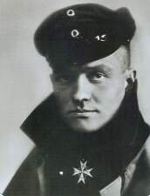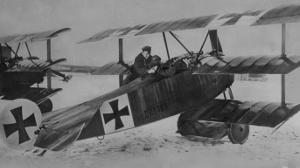One of the most famous soldiers fighting for any country during World War I was Manfred von Richthofen, better known as the "Red Baron."

Von Richthofen was a feared presence in the skies above the trenches and battlegrounds of Europe. In his brief military career, he shot down 80 enemy aircraft–far more than any other pilot.
Manfred was born into a family of Prussian nobles on May 2, 1892, in Kleinburg, in what is today Poland. He and his brothers, Lothar and Bolko, found a passion for riding horses and for hunting wild animals. Athletic and academic as well as passionate, Manfred expressed a desire to follow in the footsteps of his father, a soldier, and enrolled in the Wahlstatt military school in Berlin when he was 11.
At school, Manfred proved an adept sportsman and gymnast but a poor student. He managed to graduate and went to the Senior Cadet Academy at Lichterfelde, then the Berlin War Academy; after completing his training, he joined the German Cavalry. He gained a commission as a lieutenant in 1912 and was stationed in what is now Milicz.
When World War I began, in 1914, von Richtofen and his regiment were sent to the west, to fight in Belgium and France. Their role was to provide reconnaissance, spying on enemy positions and reporting back to their commanders.
Not long after the war began, men by the thousands on both sides dug trenches and settled in for a long war. Such a scenario didn't have much merit for men on horseback, so the German high command disbanded the cavalry. Manfred was assigned to the Signal Corps and found himself delivering messages and laying down telephone wire.
Von Richthofen wasn't happy with that. He applied for a transfer to the Air Service and went to Cologne for observer training. The airplane was a relatively new invention at that time, and planes had been used primarily for reconnaissance; however, both sides in the war had begun to outfit some of their planes with guns, in order to defend themselves and/or attack planes of the opposition.
In his first flight as an observer, von Richthofen found himself lost and unable to give the pilot directions. They landed without incident, and von Richthofen studied harder, learning how to read a map and draw a map in the air.
His first combat flight was on September 1, 1915. He had reported a group that was planning to bomb England from the air. Von Richthofen's job if they saw an enemy aircraft was to fire a rifle at the enemy; he did not succeed at this exceedingly difficult task, but he and his pilot avoided being hit by the enemy plane.

A few days later, von Richthofen was armed with a machine gun and, after encountering another enemy plane, succeeded in shooting down the enemy plane. He then began to long for an assignment flying the plane himself.
He trained under a friend and, as part of his training, made his first solo flight on October 10, 1915. He eventually passed all three of the requisite examinations and was awarded his pilot's certificate on Christmas Day of that year.
After a stint on the eastern front, von Richthofen found himself invited by his idol, the established pilot Oswald Boelcke, to join the Jagdstaffel ("hunting squadron") 2 in France. Von Richthofen proved a quick study and got his first chance at a combat patrol flight on September 17, 1916.
He shot down an enemy plane during that first "dogfight," as aerial combats were called, and gained the traditional prize of a beer mug from the German military. Von Richthofen then got the idea to commemorate each of his "kills," or shooting down of enemy planes, with a small silver trophy cup. The cup was no more than 2 inches tall and engraved with the kind of airplane, the number of crew onboard, and the date.
Von Richthofen proved adept at shooting down empty planes, notching 59 more "kills" and collecting a total of 60 silver cups before having to stop making the cups because of a silver shortage. He flew in Albatross biplanes and Fokker triplanes, proving adept at avoiding enemy gunfire while administering attacks of his own. His success he put down to training and determination.
Buoyed by his success, he had his entire plane painted bright red. Planes at the time were generally similar in color, although some pilots had some parts of their planes painted a different color. Rather than dooming its pilot because of its conspicuousness, the bright red turned pilot and plane, after repeated attempts to shoot them down failed, into a feared combination. This was also the time that von Richthofen gained the name by which he is best known: the Red Baron. The red was for the color of the plane; the baron was for his noble upbringing.
The Red Baron was a name given to von Richthofen by his enemies; his fellow Germans did not call him that, preferring to refer to him as Der rote Kampfflieger, the English equivalent of the "Red Battle Flier."
In April 1917 alone, the Red Baron shot down 21 enemy planes, bringing his total to greater than that of his hero, Boelcke, who had died in a mid-air accident the year before. German successes on the ground were starting to become few and far between, and the Red Baron's in-the-air triumphs proved an inspiration to the German Army and the German people.
During a well-earned break from the war, von Richthofen completed a set of notes that he had been taking about his experiences; this ended up being his autobiography, published as Der rote Kampfflieger.
Back at war and reunited with his brother Lothar, the Red Baron was with a group of fighter pilots who roamed the war zone; they came to be known as the "Flying Circus." During this time, von Richthofen suffered a bullet wound to the head, which resulted in his being pulled from the front to convalesce and left him with frequent headaches even after returning to the skies.
As the tide of the war turned in favor of the Allies and away from Germany, von Richthofen and his fellow fighter pilots continued to give their people inspiration in the skies. On April 21, 1918, the day after the Red Baron had claimed his 80th enemy kill, he was once again on the airborne attack, against a group of British and Canadian pilots.
This was the one aerial battle that the Red Baron did not survive. His bright red plane proved an irresistible target one too many times, and he was shot down. The same hail of bullets that caused the plane to spiral to the ground killed the pilot. The Red Baron was just 25 when he died, already a legend and destined to become even more of one.